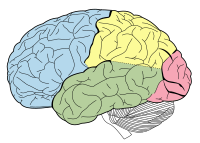
Photo from wikipedia
Background: In recent years, predicting and modeling the progression of Alzheimer’s disease (AD) based on neuropsychological tests has become increasingly appealing in AD research. Objective: In this study, we aimed… Click to show full abstract
Background: In recent years, predicting and modeling the progression of Alzheimer’s disease (AD) based on neuropsychological tests has become increasingly appealing in AD research. Objective: In this study, we aimed to predict the neuropsychological scores and investigate the non-linear progression trend of the cognitive declines based on multimodal neuroimaging data. Methods: We utilized unimodal/bimodal neuroimaging measures and a non-linear regression method (based on artificial neural networks) to predict the neuropsychological scores in a large number of subjects (n = 1143), including healthy controls (HC) and patients with mild cognitive impairment non-converter (MCI-NC), mild cognitive impairment converter (MCI-C), and AD. We predicted two neuropsychological scores, i.e., the clinical dementia rating sum of boxes (CDRSB) and Alzheimer’s disease assessment scale cognitive 13 (ADAS13), based on structural magnetic resonance imaging (sMRI) and positron emission tomography (PET) biomarkers. Results: Our results revealed that volumes of the entorhinal cortex and hippocampus and the average fluorodeoxyglucose (FDG)-PET of the angular gyrus, temporal gyrus, and posterior cingulate outperform other neuroimaging features in predicting ADAS13 and CDRSB scores. Compared to a unimodal approach, our results showed that a bimodal approach of integrating the top two neuroimaging features (i.e., the entorhinal volume and the average FDG of the angular gyrus, temporal gyrus, and posterior cingulate) increased the prediction performance of ADAS13 and CDRSB scores in the converting and stable stages of MCI and AD. Finally, a non-linear AD progression trend was modeled to describe the cognitive decline based on neuroimaging biomarkers in different stages of AD. Conclusion: Findings in this study show an association between neuropsychological scores and sMRI and FDG-PET biomarkers from normal aging to severe AD.
Journal Title: Frontiers in Computational Neuroscience
Year Published: 2021
Link to full text (if available)
Share on Social Media: Sign Up to like & get
recommendations!